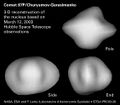Astronomy:(163132) 2002 CU11
| Discovery[1] | |
|---|---|
| Discovered by | LINEAR |
| Discovery date | 7 February 2002 |
| Designations | |
| (163132) 2002 CU11 | |
| Minor planet category | NEO · PHA · Apollo[2] |
| Orbital characteristics[2] | |
| Epoch 13 January 2016 (JD 2457400.5) | |
| Uncertainty parameter 0 | |
| Observation arc | 4600 days (12.59 yr) |
| |{{{apsis}}}|helion}} | 1.5795 astronomical unit|AU (236.29 Gm) |
| |{{{apsis}}}|helion}} | 0.85959 AU (128.593 Gm) |
| 1.2196 AU (182.45 Gm) | |
| Eccentricity | 0.29517 |
| Orbital period | 1.35 yr (491.94 d) |
| Mean anomaly | 47.609° |
| Mean motion | 0° 43m 54.48s / day (n) |
| Inclination | 48.782° |
| Longitude of ascending node | 157.77° |
| 110.54° | |
| Earth MOID | 0.00189035 AU (282,792 km) |
| Physical characteristics | |
| Mean diameter | 0.460±0.017 km[2][3] 0.730 km (assumed)[4] |
| Mass | 5.3×1011 kg (assumed) |
| Geometric albedo | 0.408±0.061[2] |
| Absolute magnitude (H) | 18.5[2] |
(163132) 2002 CU11, provisional designation 2002 CU11, is a bright, sub-kilometer asteroid, classified as near-Earth object and potentially hazardous asteroid of the Apollo group.[2] Based on absolute magnitude, it is the second largest asteroid known to have passed closer than the Moon.[5]
Description
2002 CU11 was discovered on 7 February 2002 by Lincoln Near-Earth Asteroid Research (LINEAR) at an apparent magnitude of 19 using a 1.0-meter (39 in) reflecting telescope.[1] It has an estimated diameter of 730 meters (2,400 ft).[4] The asteroid was listed on Sentry Risk Table with a Torino Scale rating of 1 on 20 March 2002.[4]
With an observation arc of 44 days, (163132) 2002 CU11 showed a 1 in 9,300 chance of impacting Earth in 2049.[6] It was removed from the Sentry Risk Table on 26 April 2002.[7] It is now known that on 3 September 2049 the asteroid will be 0.0843 astronomical unit|AU (12,610,000 km; 7,840,000 mi) from Earth.[8]
Even though using an epoch of 27 June 2015 gives 2002 CU11 an Earth-MOID of 0.0000093 AU (1,390 km; 860 mi),[2] the asteroid does not make any threatening approaches to Earth in the foreseeable future.
| Date | Distance from Earth |
|---|---|
| 1925-08-30 | 0.0023 astronomical unit|AU (340,000 km; 210,000 mi) |
| 2014-08-30 | 0.0346 AU (5,180,000 km; 3,220,000 mi) |
| 2049-09-03 | 0.0843 AU (12,610,000 km; 7,840,000 mi) |
| 2080-08-31 | 0.0042 AU (630,000 km; 390,000 mi) |
The close approach of 2080 will cause an uncertainty of 4 minutes for the close approach time of 2084.[8]
References
- ↑ 1.0 1.1 "MPEC 2002-C44 : 2002 CU11". IAU Minor Planet Center. 2002-02-08. https://www.minorplanetcenter.net/mpec/K02/K02C44.html. Retrieved 2013-09-18. (K02C11U)
- ↑ 2.0 2.1 2.2 2.3 2.4 2.5 2.6 "JPL Small-Body Database Browser: 163132 (2002 CU11)". Jet Propulsion Laboratory. Archived from the original on 28 May 2019. https://web.archive.org/web/20190528050531/https://ssd.jpl.nasa.gov/sbdb.cgi?sstr=2002CU11. Retrieved 7 April 2016.
- ↑ "LCDB Data for (163132) 2002 CU11". Asteroid Lightcurve Database (LCDB). http://www.minorplanet.info/PHP/generateOneAsteroidInfo.php?AstInfo=163132. Retrieved 16 June 2020.
- ↑ 4.0 4.1 4.2 "Current Impact Risks (2002 CU11)". Near-Earth Object Program. NASA. 2002-03-21. Archived from the original on March 21, 2002. https://web.archive.org/web/20020321092735/http://neo.jpl.nasa.gov/risk.
- ↑ NEO Earth Close Approaches @ JPL CNEOS
Select "Nominal dist <= 1 LD", "Past only", Sort by "H (mag)" - ↑ Andrea Milani; Giovanni Valsecchi (2002). "The problem with 2002 CU11". Spaceguard / Tumbling Stone. http://spaceguard.rm.iasf.cnr.it/tumblingstone/issues/num12/eng/2002cu11.htm. Retrieved 2013-09-18.
- ↑ "Date/Time Removed". NASA/JPL Near-Earth Object Program Office. http://neo.jpl.nasa.gov/risk/removed.html. Retrieved 2013-09-18.
- ↑ 8.0 8.1 8.2 "JPL Close-Approach Data: 163132 (2002 CU11)". https://ssd.jpl.nasa.gov/sbdb.cgi?sstr=2002CU11;cad=1#cad. Retrieved 2013-09-18.
External links
- (163132) 2002 CU11 at NeoDyS-2, Near Earth Objects—Dynamic Site
- Ephemeris · Obs prediction · Orbital info · MOID · Proper elements · Obs info · Close · Physical info · NEOCC
- (163132) 2002 CU11 at ESA–space situational awareness
- (163132) 2002 CU11 at the JPL Small-Body Database
| Preceded by (152680) 1998 KJ9 |
Large NEO Earth close approach (inside the orbit of the Moon) 30 August 1925 |
Succeeded by 2002 JE9 |
 |




